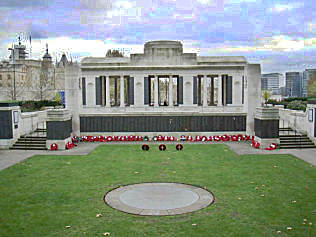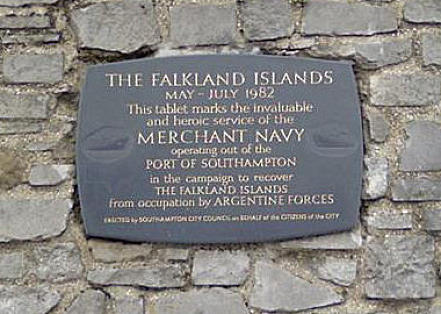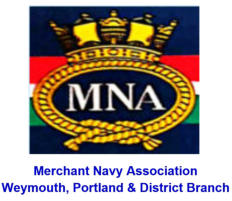

MERCHANT NAVY MEMORIALS





The
memorial,
carved
from
Portland
stone,
was
unveiled
during
a
special
service
on
Wednesday
9
th
November
2016
organised
by
the
Weymouth,
Portland
and
District
branch
of
the
Merchant
Navy
Association
(MNA).
Before
the
memorial
was
hoisted
into
position
on
the
Esplanade,
a
silver
coin
that
had
been
minted
from
the
bullion
cargo
of
a
sunken
World
War
Two
merchant
ship
was placed under its plinth.
Paul
Compton
of
the
MNA
said:
"It
has
been
a
long
voyage.
Who
would
have
thought
that
in
just
under
18
months
we
would
have
raised
more
than
£20,000.
It
is
a
credit
to
all
of
us
-
the
whole
town.
Everything
you
see
on
this
memorial
was
made
in
Dorset and it is beautiful. Thank you to everyone who helped and to those who came today."
The
Lord
Lieutenant
for
Dorset,
Angus
Campbell,
said:
“If
ever
a
town,
borough
or
port
deserved
to
have
a
memorial
like
this,it
has
got
to
be
Weymouth
and
Portland.
The
fact
that
we
lost
more
than
51
ships
in
the
Battle
for
the
Atlantic
and
over
30,000
sea
men lost their lives in the First and Second World Wars is something perhaps we haven’t given a lot of attention to in the past.”


This Memorial is dedicated to the merchant seamen and fishermen who lost their lives in World War 2. The Swansea Merchant
Navy Association took eight years to raise the money for the granite and marble memorial.
The memorial was designed by local sculptor Philip Chatfield.
The Seafarers' Memorial at Battery Point, Portishead, was erected by the North Somerset Branch of the
Merchant Navy Association in 2005











The Tower Hill Memorial is a Commonwealth War Graves Commission war memorial
on the south side of Trinity Square Gardens, in London, England. The memorial
commemorates those from the Merchant Navy and fishing fleets who died during
both world wars and have "no grave but the sea". The memorial was designed by
Edwin Lutyens with sculpture work by William Reid Dick, the Second World War
extension was designed by Edward Maufe with sculpture work by Charles Wheeler.
The First World War memorial takes the form of a vaulted corridor, 21.5 metres long,
7 metres wide and 7 to 10 metres high. Inside are 12 bronze plaques engraved with
12,000 names. Those commemorated include Victoria Cross recipient, Archibald
Bisset Smith.
The Second World War memorial takes the form of a semi-circular sunken garden
located behind the corridor, to its north. It contains the names of 24,000 British
seamen and 50 Australian seamen, listed on the walls of the sunken garden. In the
centre of the garden is a pool of bronze, engraved with a compass pointing north.
Between the two memorials are two columns with statues representing an officer (western column) and a seaman (eastern).
Not all Merchant Seamen who died during wartime, and have no known grave, are commemorated here - they may be
commemorated elsewhere, for example, the Liverpool Naval Memorial.
The memorial was unveiled by Queen Mary on 12 December 1928 and the Second World War extension by Queen Elizabeth II on
5 November 1955


A one and a half life size depiction of a sailor at the wheel, on a sloping base to give the impression
of being at sea on an uneven keel. Overlooking the Tyne, he gazes keenly ahead to the dangers
that may come. The pedestal is yellow stone with a simple square-cut cornice.
The idea for a memorial to the region's merchant seamen lost in war was first mooted in 1988 by
the retired President of the National Union of Seamen, Jim Slater. Its cost of £56,000 was raised by
public subscription, whilst the plinth was paid for by Tyne and Wear Development Corporation as a
contribution to its regeneration of the surrounding area. As stated in the inscription, it was unveiled
by the Duchess of Mountbatten, whose husband had a long association with seafaring.
Incised on plaque on front of pedestal: MERCHANT NAVY MEMORIAL This statue was unveiled by
Countess Mountbatten of Burma on 19th September, 1990 in memory of the thousands of merchant
seamen who sailed from this port and lost their lives in World War II.
Unrecognised, you put us in your debt;
Unthanked, you enter or escape the grave;
Whether your land remember or forget,
You saved the land, or died to try to save.
JOHN MASEFIELD Poet Laureate.
The sculptor was Robert Olley and it was cast at Burleighfield foundry







The New Memorial Unveiled on Merchant Navy Day, 3rd September 2019
The Original Memorial 1955
HISTORIC SHIPS






Wick's memorial to lost seafarers is "something special for the town" and one of the top monuments in the north of Scotland.
Rising to a height of five metres above the Braehead, overlooking the harbour and bay, the solitary bronze figure symbolises
how the sea "gives with one hand and takes away with the other".
The design for the statue, by Alan Beattie Herriot, was commissioned by the Seafarers Memorial Group, a committee of
volunteers.. The group raised more than £100,000 for a monument to all seafarers lost at sea from or in the WK registration
area, which stretches from Talmine in the west across to Stroma and down as far as Golspie. Their chairman, Willie Watt, said
there had been "a magic response" and "amazing support" for the project. "It allows families with tragic tales to tell to actually
have somewhere to go to reflect. was selected to create the sculpture.
Mike Coupland, Secretary of Caithness Branch writes: This is not just a war or a Merchant Navy memorial, but a memorial to
everyone ever lost at sea in the Wick fishing registration area or from that area. There are hundreds of names that we know of
so it is meant for all of them.


